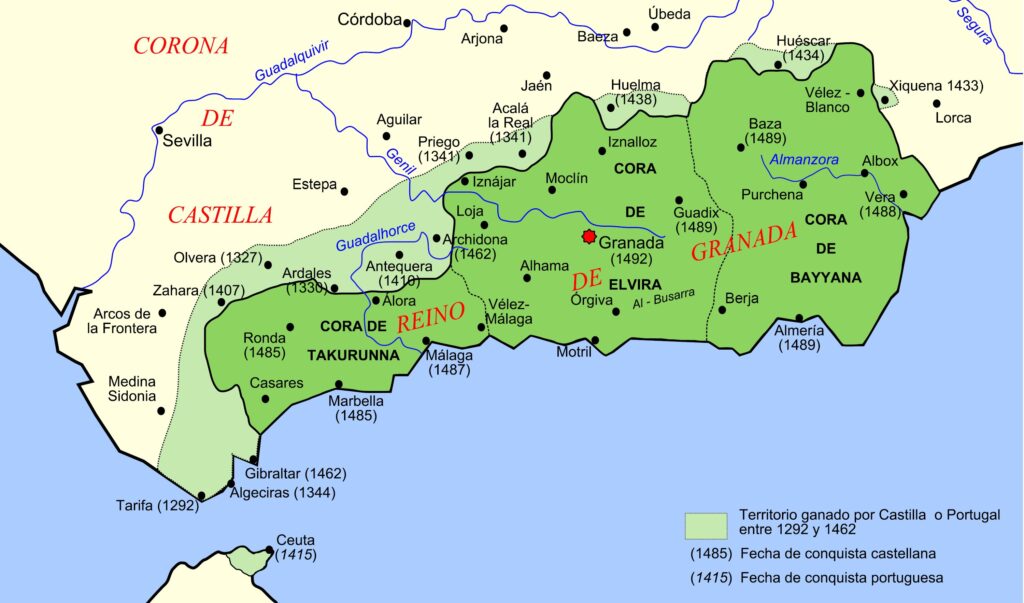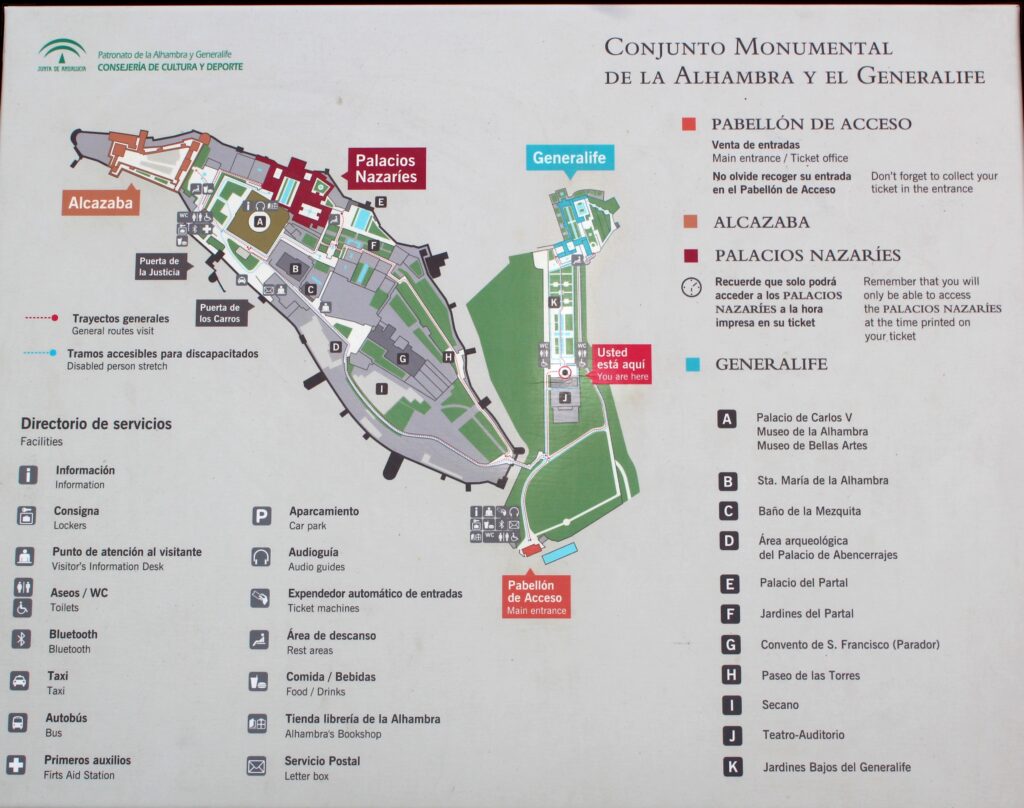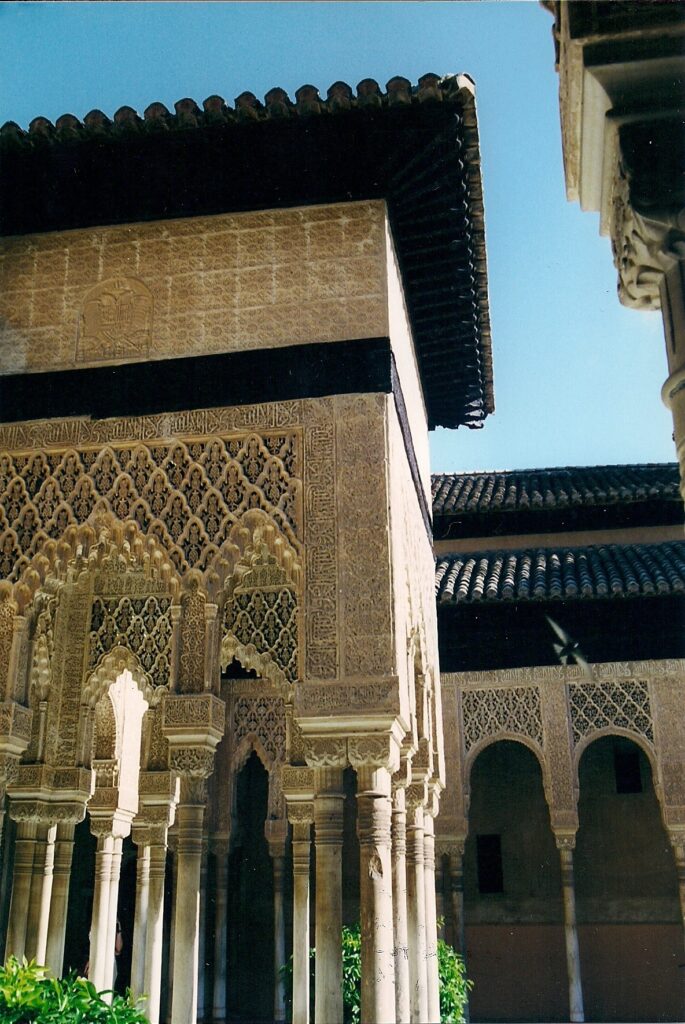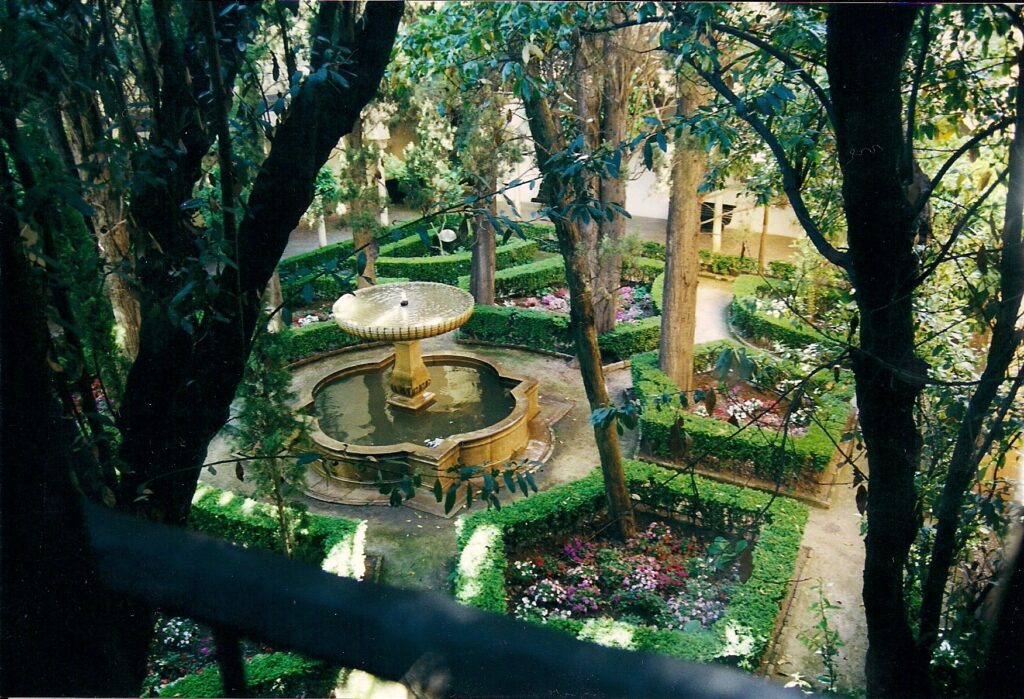Un palacio-fortaleza a través de los siglos

Metas de aprendizaje:
En este capítulo vamos a enfocarnos principalmente en meta 4 Poder nombrar algunos autores y artistas claves de España y describir o resumir sus obras maestras; pero daremos atención a meta 3 Poder identificar los periodos principales de la historia española, meta 5 Poder describir cómo era la vida en cada periodo principal de la historia española, meta 6 Poder describir los estilos artísticos y arquitecturales de cada periodo principal de la historia española, meta 8 Poder demostrar la abilidad de tomar diferentes puntos de vista en el contexto de la historia y cultura española, y meta 9 Poder explicar la relevancia actual de aspectos de la cultura e historia española.
Personas o cosas para identificar:
- la Alhambra
- el reino de Granada
- el palacio de Carlos V
- Tales of the Alhambra por Washington Irving
Preguntas de preparación:
- ¿Qué es la Alhambra, y cómo ha sido usada durante su historia?
- ¿Cómo ha cambiado la Alhambra durante su historia?
- ¿Cómo es, en su construcción y su decoración?
- ¿Cuáles son algunas leyendas asociadas con la Alhambra?
![]()
La Alhambra de Granada es una de las palacio-fortalezas musulmanas más hermosas y que mejor se ha conservado hasta hoy en día.
El reino de Granada
El califato de Córdoba se colapsó en una guerra civil al comienzo del siglo XI, y sus provincias se dividieron en los Reinos Taifas; de estos reinos, el que sobrevivió por más tiempo en las guerras con los reinos cristianos era el reino de Granada en el sureste de la Península Ibérica.

Orígenes de la Alhambra
La Alhambra es un conjunto[1] de palacios y jardines, todo encerrado[2] por un muro fortificado y bien ubicado[3] en una colina sobre la ciudad de Granada. El nombre viene del árabe y significa «castillo rojo» por el color rojizo[4] de los muros exteriores. Su parte más antigua es la Alcazaba, una ciudadela[5] construida en el siglo XIII donde antes había otra fortificación construida en el siglo XI. La dinastía de los reyes nazaríes[6] construyó sus palacios y jardines en la colina en parte para escapar el calor de la ciudad, y en parte porque era un lugar defensible.

La Alhambra pasó de ser la corte real de los nazaríes a la corte real de Castilla en 1492 cuando los reyes Fernando e Isabela conquistaron Granada. El palacio de Carlos V, el nieto de Fernando e Isabela, es un edificio monumental en estilo del Renacimiento que él mandó construir entre los palacios musulmanes mucho más pequeños, creando un contraste notable de estilos.
Una visita a la Alhambra en siglo XIX
Washington Irving (1783-1859) era un escritor, historiador y diplómata norteamericano famoso por sus cuentos fantásticos, por ejemplo «The Legend of Sleepy Hollow.» Pero él hablaba el español muy bien y también traducía libros del español al inglés. En 1829 él se quedó por algunos meses en la Alhambra, y en 1832 publicó su libro de descripciones y leyendas, Tales of the Alhambra. Aquí están algunos pasajes:
… While we were talking, the door was opened by a plump little black-eyed Andalusian damsel, whom Mateo addressed as Dolores[7], but who from her bright looks and cheerful disposition evidently merited a merrier name. Mateo informed me in a whisper that she was the niece of Tia Antonia, and I found she was the good fairy who was to conduct us through the enchanted palace. Under her guidance we crossed the threshold, and were at once transported, as if by magic wand, into other times and an oriental realm, and were treading the scenes of Arabian story. Nothing could be in greater contrast than the un-promising exterior of the pile with the scene now before us.

We found ourselves in a vast patio or court one hundred and fifty feet in length, and upwards of eighty feet in breadth, paved with white marble, and decorated at each end with light Moorish peristyles[8], one of which supported an elegant gallery of fretted[9] architecture. Along the mouldings of the cornices[10] and on various parts of the walls were escutcheons[11] and ciphers, and cufic and Arabic characters in high relief, repeating the pious mottoes of the Moslem monarchs, the builders of the Alhambra, or extolling their grandeur and munificence[12]. Along the centre of the court extended an immense basin or tank (estanque) a hundred and twenty-four feet in length, twenty-seven in breadth, and five in depth, receiving its water from two marble vases. Hence it is called the Court of Alberca (from al Beerkah, the Arabic for a pond or tank). Great numbers of gold-fish were to be seen gleaming through the waters of the basin, and it was bordered by hedges of roses.
Passing from the court of the Alberca under a Moorish archway, we entered the renowned court of Lions. No part of the edifice gives a more complete idea of its original beauty than this, for none has suffered so little from the ravages of time. In the centre stands the fountain famous in song and story. The alabaster[13] basins still shed their diamond drops; the twelve lions which support them, and give the court its name, still cast forth crystal streams as in the days of Boabdil[14]. The lions, however, are unworthy of their fame, being of miserable[15] sculpture, the work probably of some Christian captive.
The court is laid out in flower-beds, instead of its ancient and appropriate pavement of tiles or marble; the alteration, an instance of bad taste, was made by the French when in possession of Granada[16]. Round the four sides of the court are light Arabian arcades of open filigree work supported by slender pillars of white marble, which it is supposed were originally gilded. The architecture, like that in most parts of the interior of the palace, is characterized by elegance, rather than grandeur; bespeaking a delicate and graceful taste, and a disposition to indolent[17] enjoyment. When one looks upon the fairy tracery of the peristyles, and the apparently fragile fretwork of the walls, it is difficult to believe that so much has survived the wear and tear of centuries, the shocks of earthquakes, the violence of war, and the quiet, though no less baneful, pilferings of the tasteful traveller: it is almost sufficient to excuse the popular tradition, that the whole is protected by a magic charm.

On one side of the court a rich portal opens into the hall of the Abencerrages[18]; so called from the gallant cavaliers of that illustrious line who were here perfidiously massacred. There are some who doubt the whole story, but our humble cicerone[19] Mateo pointed out the very wicket of the portal through which they were introduced one by one into the court of Lions, and the white marble fountain in the centre of the hall beside which they were beheaded. He showed us also certain broad ruddy stains on the pavement, traces of their blood, which, according to popular belief, can never be effaced.
Finding we listened to him apparently with easy faith, he added that there was often heard at night, in the court of Lions, a low confused sound, resembling the murmuring of a multitude; and now and then a faint tinkling, like the distant clank of chains. These sounds were made by the spirits of the murdered Abencerrages, who nightly haunt the scene of their suffering and invoke the vengeance of Heaven on their destroyer.
The sounds in question had no doubt been produced, as I had afterwards an opportunity of ascertaining, by the bubbling currents and tinkling falls of water conducted under the pavement through pipes and channels to supply the fountains; but I was too considerate to intimate[20] such an idea to the humble chronicler of the Alhambra.
Encouraged by my easy credulity, Mateo gave me the following as an undoubted fact, which he had from his grandfather:
There was once an invalid[21] soldier, who had charge of the Alhambra to show it to strangers: as he was one evening, about twilight, passing through the court of Lions, he heard footsteps on the hall of the Abencerrages; supposing some strangers to be lingering there, he advanced to attend upon them, when to his astonishment he beheld four Moors richly dressed, with gilded cuirasses[22] and cimeters, and poniards glittering with precious stones. They were walking to and fro, with solemn pace; but paused and beckoned to him. The old soldier, however, took to flight, and could never afterwards be prevailed upon to enter the Alhambra. Thus it is that men sometimes turn their backs upon fortune; for it is the firm opinion of Mateo, that the Moors intended to reveal the place where their treasures lay buried. A successor to the invalid soldier was more knowing; he came to the Alhambra poor; but at the end of a year went off to Malaga, bought houses, set up a carriage, and still lives there one of the richest as well as oldest men of the place; all which, Mateo sagely surmised, was in consequence of his finding out the golden secret of these phantom Moors.

La Alhambra en la modernidad
El pasaje arriba menciona la mala condición de la Alhambra; ya desde los 1700 el sitio era una propiedad de la Corona Española pero medio abandonada. Veremos más tarde en el curso que entre 1808-1812 los franceses invadieron y ocuparon España; ellos volaron[23] partes del muro defensivo cuando se retiraron del lugar. También veremos más tarde en el curso que el Romanticismo despertó un aprecio en el siglo XIX para los monumentos y vestigios de la historia, especialmente la Edad Media, y fue entonces, en la época de Washinton Irving, que la Alhambra comenzó a ser mejor conocida por su hermosura y significado histórico. Fue nombrada Monumento Nacional en 1870, y desde entonces ha recibido atención cuidadosa de preservación y restauración; la Alhambra es ahora uno de los sitios más visitados por turistas en el país.
![]()
Resumen cronológico:
- siglo IX: Construcción de la primera ciudadela musulmana en la Alhambra
- siglo XI: Construcción el primer palacio musulmán en la Alhambra
- siglo XIII: Construcción de los palacios nazaríes y el Generalife en la Alhambra
- 1492: Fernando e Isabela conquistan el reino de Granada
- 1526: Carlos V ordena la construcción de su palacio en la Alhambra
- siglo XVIII: La Alhambra es básicamente abandonada por la Corona Española
- 1808-1812: Ocupación por tropas francesas
- 1829: Washington Irving se queda en la Alhambra
- 1870: La Alhambra es declarada Monumento Nacional de España
Preguntas para composición y/o discusión:
- Mira este video sobre el proceso de restauración de la Fuente de los Leones entre 2002-2012, y narra el proceso en tus propias palabras usando los tiempos pasados. ¿Cuáles precauciones tomaron en el proceso y por qué? ¿Cómo eran la fuente y los leones antes y después de la restauración?
- Busca información y fotos sobre el palacio de Carlos V en la Alhambra y analiza el significado de su inclusión en el recinto de la Alhambra. ¿Por qué pensaban los reyes españoles en aquel tiempo que respetaban el lugar, y por qué algunas personas piensan ahora que faltaban respeto al lugar?
- Este verano la primera cosa que sale en el web del Patronato de la Alhambra es un aviso sobre tomar precauciones contra el calor excesivo; también en 2024 la Alhambra vio un récord 2,72 millones de visitantes en el año. Busca más información sobre cómo y cuándo es mejor visitar la Alhambra y desarrolla planes para una visita de 3 días y 2 noches a Granada. Explica cuáles lugares vas a visitar, cuándo y por qué.
Enlaces para expansión:
- Web oficial del Patronato de la Alhambra y el Generalife, con historia, fotos y detalles sobre cómo visitar
- Video de una entrevista sobre cómo mantienen los jardines en la Alhambra
- El Alcázar en Sevilla y la Aljafería de Zaragoza son otras palacio-fortalezas musulmanas que puedes visitar
Punto gramatical: Posesión con «de»
En inglés tenemos la opción de expresar la posesión o con el apóstrofe y «s», o con una frase de «of»; pero en español no existe el uso del apóstrofe, y solamente podemos expresar la posesión con frases usando «de.»
Ejemplos de la lectura:
- El palacio de Carlos V, el nieto de Fernando e Isabela, es un edificio monumental en estilo del Renacimiento = The palace of Charles the Fifth, Ferdinand and Isabela’s grandson, is a monumental building in the Renaissance style.
- Mateo informed me in a whisper that she was the niece of Tia Antonia = …Tia Antonia’s niece = Mateo me me informó en un susurro que ella era la sobrina de la Tía Antonia.
- El pasaje arriba menciona la mala condición de la Alhambra = The above passage mentions the Alhambra’s poor condition.
Este libro Elementary Spanish, vol 1 en LibreTexts Humanities tiene práctica con la posesión con «de» además de los adjetivos posesivos.
![]()
Fuentes:
- Línea de tiempo e imagen divisor horizontal se crearon para este proyecto y han sido soltados al (dominio público) por su autora, Elizabeth Small.
- Título de imagen enlazado a su fuente por Autor (nombre de permiso enlazado a sitio con definición en creative commons), via Wikimedia Commons
- Foto de un mapa de la Alhambra por Arthur Chapman y Audrey Bendus, 2014 (CC BY-NC-SA 2.0), via Flickr
- Mapa del Reino Nazarí de Granada por Tyk based on Image:Iberian Peninsula base map.svg created by Redtony, (CC BY-SA 3.0), via Wikimedia Commons
- Fotos del exterior de los palacios nazaríes y de la entrada a la Sala de los Abencerrajes, y del Jardín de Lindaraja ha sido soltadas al (dominio público) por sus autoras.
- Tales of the Alhambra (1832) por Washington Irving (dominio público).
Glosario:
- conjunto (sust. masc) = complex, group of buildings and spaces ↵
- encerrado (adj. y participio pasado de encerrar) = enclosed; todo encerrado por un muro fortificado = all enclosed by a fortified wall ↵
- ubicado (adj. y participio pasado de ubicar) = located, placed ↵
- rojizo (adj.) = reddish ↵
- ciudadela (sust. fem.) = citadel, fortified tower or military installation ↵
- reyes nazaríes = Nasrid kings ↵
- Dolores = the original meaning of the name is "pains, suffering", a religious reference ↵
- peristyle (noun, architectural) = a row of columns surrounding a space within a building such as a court or internal garden or edging a veranda or porch ↵
- fretted (adj, design) = having a geometric, interlaced, repeating pattern ↵
- cornice (noun, archetectural) = an ornamental molding around the wall of a room just below the ceiling ↵
- escutcheon (noun) = shield, coat of arms or plaque; escutcheons and ciphers = decorative elements that are symbolic in nature such as plaques and decorative lettering ↵
- munificence (adj.) = lavishly generous, having great wealth and sharing it with others (not to be confused with "magnificence") ↵
- alabaster (noun) = a kind of very fine white stone used in ornamental sculpture ↵
- Boabdil = the last Muslim king of Granada, he lost his kingdom to Ferdinand and Isabela in 1492 and went into exile ↵
- miserable sculpture: Remember that the sculptures were quite eroded in Irving's time, and the Nasrid kings would have filled their palaces with the work of their own highly skilled artisans. The lions are stylized rather than realistic and were meant to be so. ↵
- ...possession of Granada: 1808-1812. See below and later in the course about the Napoleonic occupation of Spain ↵
- indolent (adj.) = lazy. Remember that this was written in the 1830s and participates in the stereotypes of its time. ↵
- Abencerrages = Abencerrajes = A wealthy and powerful family in the Muslim kingdom of Granada who were killed by a jealous king ↵
- cicerone (noun) = guide. This is a reference to Dante's "Inferno", in which the Roman poet Cicero guided Dante in his tour of the levels of Hell. ↵
- intimate (verb) = hint, suggest ↵
- invalid soldier: This is a reference to the organization of los Soldados Inválidos, disabled former soldiers who were hired to look after the Alhambra in the 17th and 18th centuries ↵
- cuirass (noun) = a piece of armor consisting of breastplate and backplate connected together; cuirasses and cimeters (scimitars), and poniards = armor and swords, and daggers ↵
- volaron (pretérito de volar) = exploded, blew up ↵